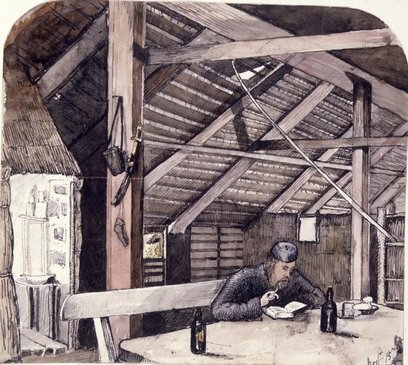SOLDIERS OF EMPIRE
The Project
Between 1860 and 1870 around 12,000 British soldiers and sailors served in New Zealand in a set of conflicts described by the War Office in 1902 as among the fifteen ‘principal British wars of 1857-1899.’1 The wars have been variously known as the 'Maori Wars', 'Land Wars', 'New Zealand Wars' and imperial wars.
At the heart of the wars was a struggle for sovereignty. Maori sought to maintain autonomy and land, settlers backed by the imperial government sought to assert British authority. The outcome had lasting consequences on the shaping of Maori-Pakeha relations in New Zealand’s history. Such contests between local resistance and imperial authority formed part of the wider history of the violent dimension to British and other European imperial expansion in the 18th-20th centuries. If we know much about war, we know little of the men who fought; of the trajectories of mobility that saw them fighting around the world, or of their garrison culture.
Rebecca Lenihan has recently completed a path breaking study detailing the profile of the Scots who made New Zealand their home as migrant settlers in the decades 1840-1920. A disproportionately Scottish settler population makes New Zealand a distinctive part of the 19th and 20th-century diaspora.
In 2014 Charlotte and Rebecca became interested in the paths that led to the 1860s wars from the colonists they had previously studied. For Charlotte Henare Taratoa, the scholar who studied with the Selwyns at St John's, but who fought and died in the battle against the British in 1864, provided a direct link between areas of research. In the year that marked the 150th anniversary of the major battles of the 1860s wars, they developed a site to tell the history of the battle of Te Ranga with students in HIST 316: New Zealand Social History at Victoria University of Wellington. The idea of this larger project grew from that undertaking. The project is supported by the Marsden Fund over a three-year period 2015-2018. The Marsden Fund supporting excellent fundamental research is administered by the Royal Society of New Zealand - Te Apārangi on behalf of the Marsden Fund Council and operates under the Terms of Reference issued by the Minister of Science and Innovation. |
The Project
|
Footnotes
1. John Darwin Unfinished Empire. The Global Expansion of Britain, London: Penguin, 2012, 117
2. James Cowan, The New Zealand Wars, Wellington: Government Printer, 1922; Keith Sinclair, The Origins of the Maori Wars, Wellington: New Zealand University Press, 1957; James Belich, The New Zealand Wars and the Victorian Interpretation of Racial Conflict, Auckland: Auckland University Press, 1986; Hazel Riseborough, Days of Darkness, Wellington: Allen and Unwin, 1989; Ranginui Walker, Ka Whawhai Tonu Matou: Struggle Without End, Auckland: Penguin, 1990 Rev. Ed. 2004; Nigel Prickett, Landscapes of Conflict: a Field Guide to the New Zealand Wars, Auckland: Random House, 2002; Kelvin Day, ed. Contested Ground. Te Whenua I Tohea. The Taranaki Wars 1860-1881, Wellington: Huia, 2010.
1. John Darwin Unfinished Empire. The Global Expansion of Britain, London: Penguin, 2012, 117
2. James Cowan, The New Zealand Wars, Wellington: Government Printer, 1922; Keith Sinclair, The Origins of the Maori Wars, Wellington: New Zealand University Press, 1957; James Belich, The New Zealand Wars and the Victorian Interpretation of Racial Conflict, Auckland: Auckland University Press, 1986; Hazel Riseborough, Days of Darkness, Wellington: Allen and Unwin, 1989; Ranginui Walker, Ka Whawhai Tonu Matou: Struggle Without End, Auckland: Penguin, 1990 Rev. Ed. 2004; Nigel Prickett, Landscapes of Conflict: a Field Guide to the New Zealand Wars, Auckland: Random House, 2002; Kelvin Day, ed. Contested Ground. Te Whenua I Tohea. The Taranaki Wars 1860-1881, Wellington: Huia, 2010.
Banner image: Detail of Breech loading rifle, Snider action, made by the Royal Small Arms Factory, Enfield, England, 1861. Calibre .577, Museum of New Zealand, Te Papa Tongarewa, DM000046
Favicon image: Thomas Matravers album, Sir George Grey Special Collections, 3-137-26d, Auckland Libraries
Favicon image: Thomas Matravers album, Sir George Grey Special Collections, 3-137-26d, Auckland Libraries
Copyright © 2021



